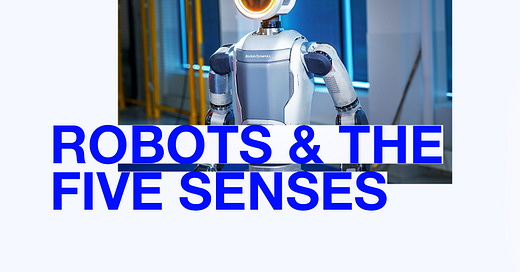Hey, friends—welcome back to online-offline, a newsletter about technology, culture, and the future. Hello to new subscribers! I’m glad you’re here. If you haven’t already, please support my work by subscribing below. Now, let’s dive in.
The humanoids are here.
Boston Dynamics unveiled their new project yesterday—a humanoid robot with crazy motion. Naturally, it has a spinning head and wild dexterity. I don’t want to ever be within 1,000 feet of this thing, yet I was more than comfortable taking a Waymo autonomous ride in San Francisco last month. AI has gotten really really good and, combined with hardware, it’ll make for some special and weird futures.
Perception AI, a quick summary
In my last essay, I emphasized how machines are made in our (human) likeness. Today, machines have three of the five human senses. In order to understand and interact with the world, machines need visual, auditory, and tactical processing. These complicated processes combine several technologies like deep learning, natural language processing, computer vision, and much more. And, we’re just getting started. Recent studies show that machines can learn how to smell and there’s even a startup for device olfaction, Osmo. and even taste. Similarly, recent studies show AI can determine or predict taste. The bots are almost human!
Okay, so what does this even mean and why should you care?
Autonomous vehicles are already here—Waymo, Tesla, and the cars that parallel park for you.
Improvements in healthcare with more accurate, faster imaging and diagnostics.
Better weather imaging and climate risk assessment.
More personalized and immersive retail experiences.
Smarter home devices that can anticipate your needs.
And, much more.
Ambient computing, today and tomorrow
I’m most interested in the intersection of perception AI and ambient computing, which I covered in my piece about AI hardware last year. Just imagine the changes in:
Home health, safety, and assisted living.
Patient monitoring and support in hospitals and other settings.
General AI co-pilots and assistants.
Manufacturing processes and quality control.
Enterprise cross-functional collaboration.
This is a high-level view. Ultimately, machines will be able to anticipate (perception AI) and fulfill our needs without prompting (ambient computing). As scary as it is, that Boston Dynamics robot may be the best assisted living nurse we’ve ever seen. Let’s wait and see …






